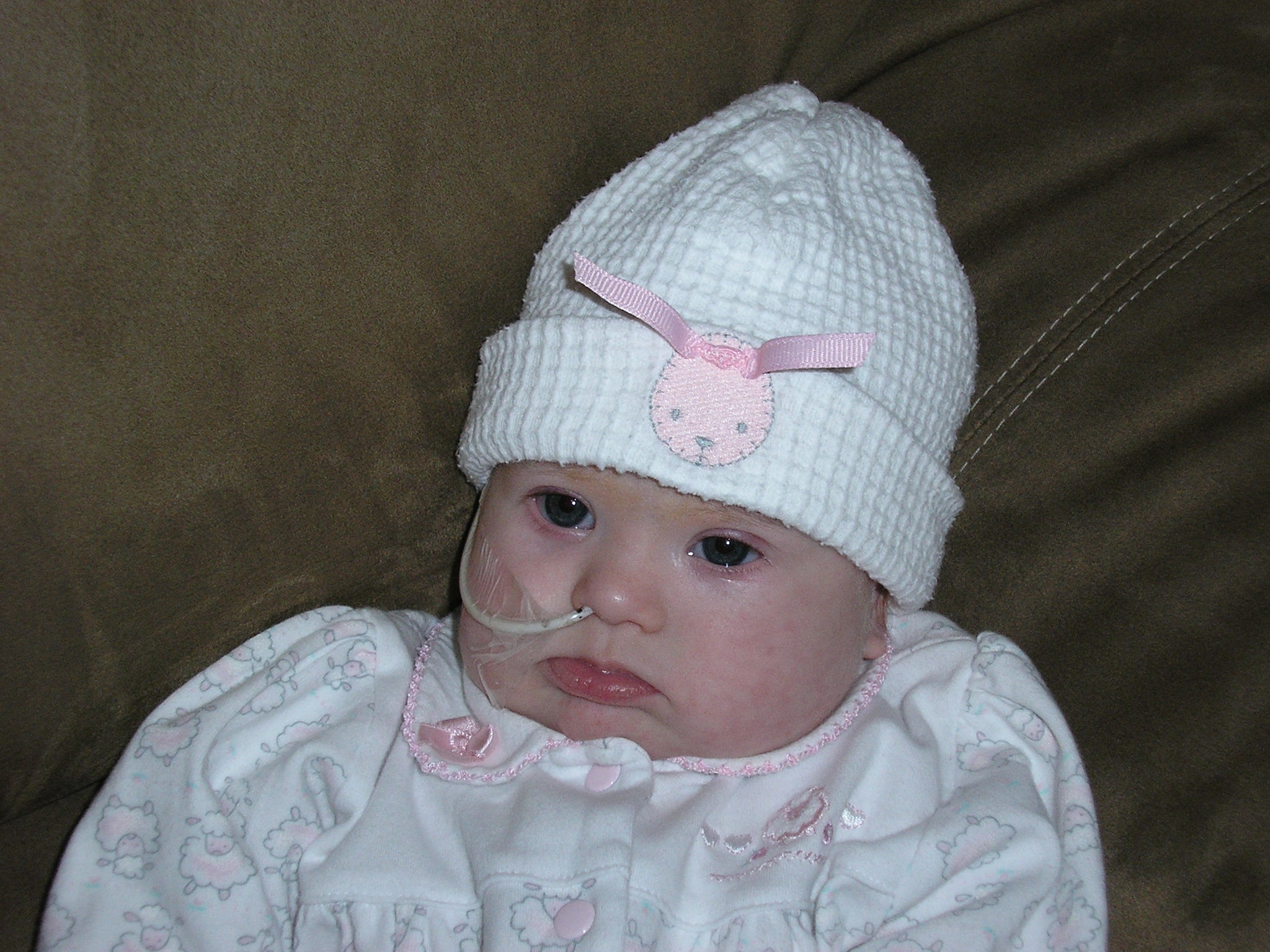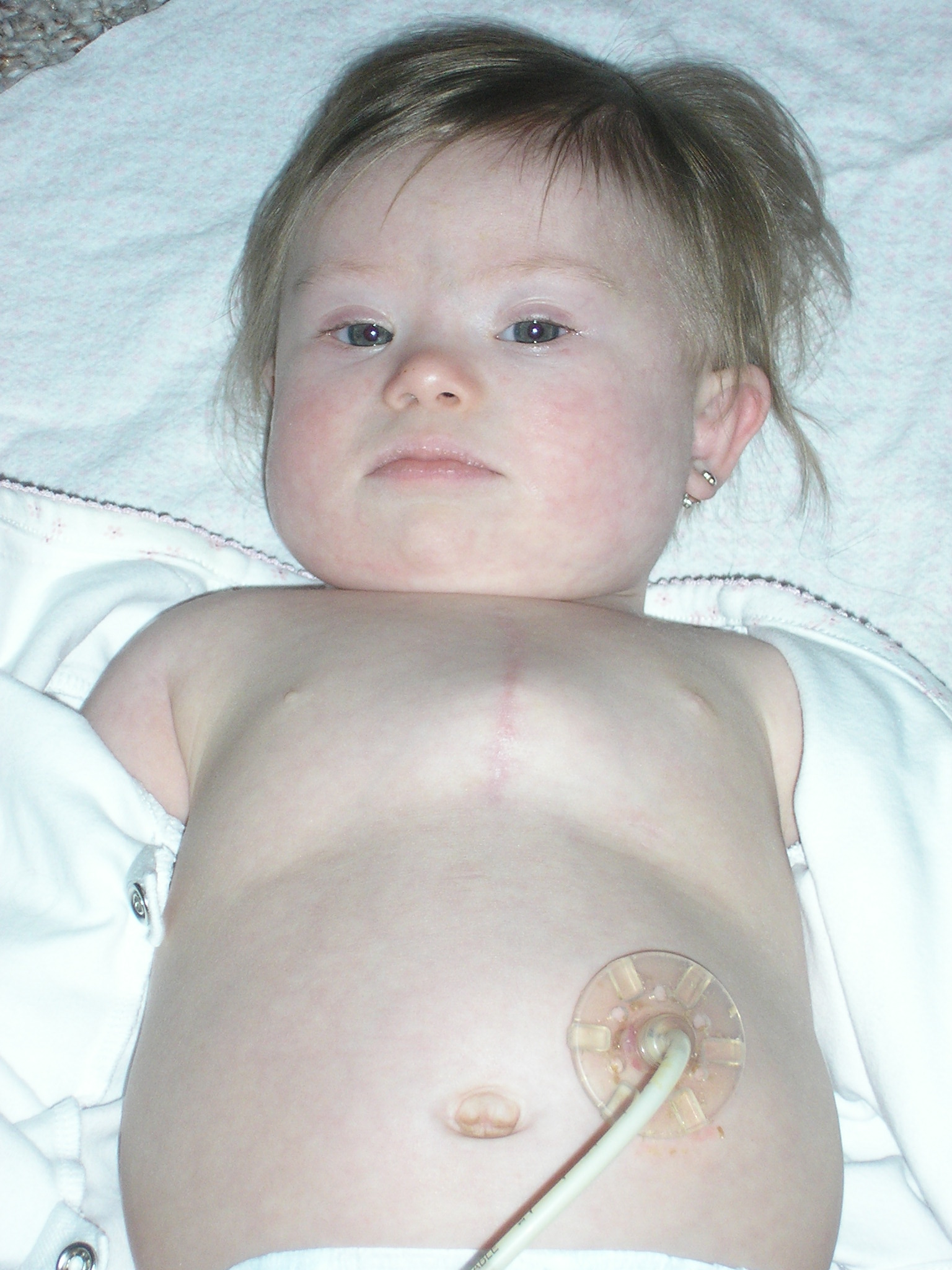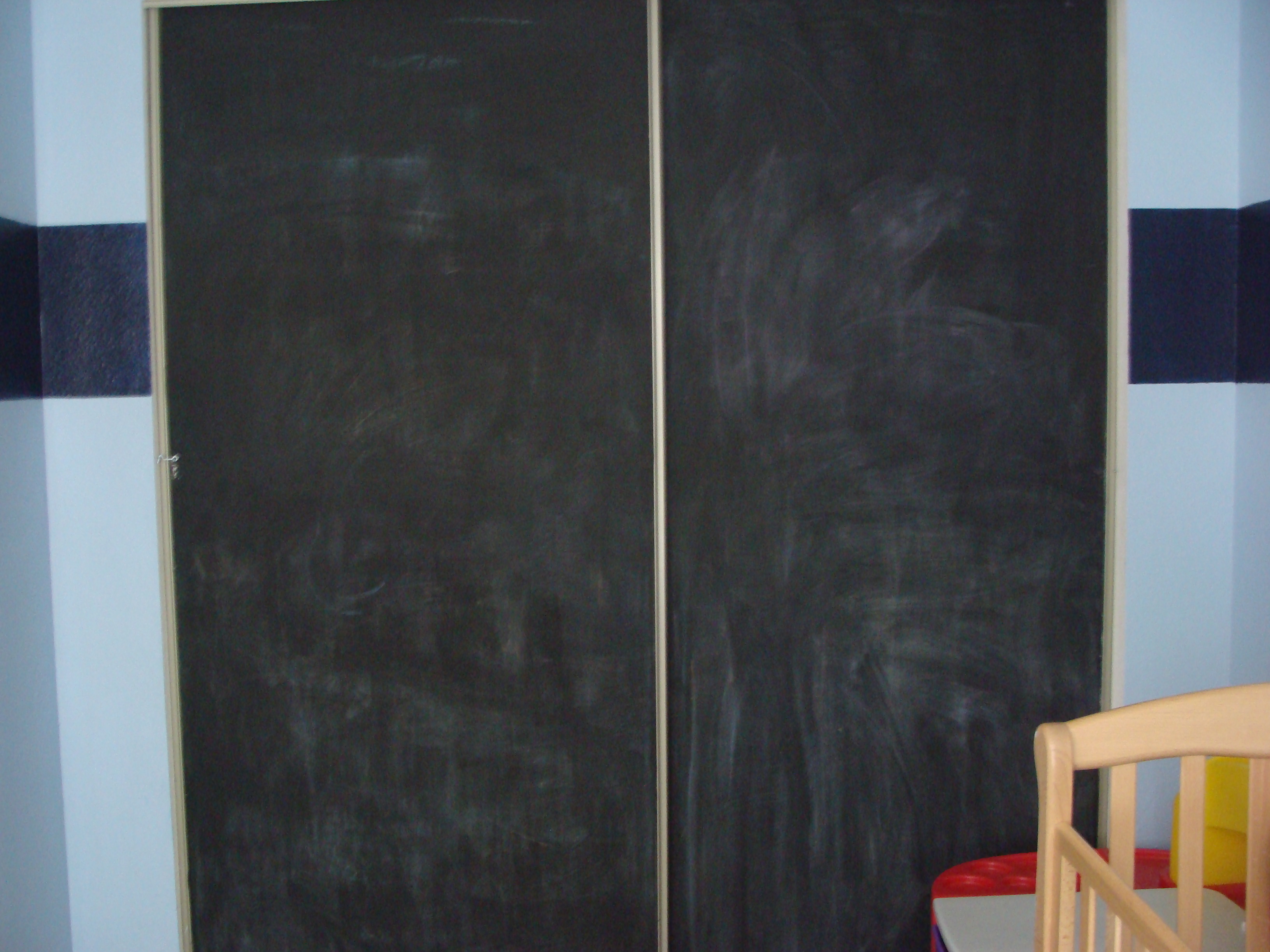
My daughter, Darah was tube fed for the first two years of her life.  Most people had absolutely no idea what her feeding tube was and I got a lot of stares or quick “look aways” and a lot of questions about what those tubes were for. Darah was born with a very serious heart defect. This heart defect made her incredibly tired. In addition to her heart defect, she also has low muscle tone, because she had Down syndrome. The combination of low muscle tone and her exhaustion from her heart defect made her suck/swallow/breathe coordination impossible. From day one, we had to sustain her life by using a feeding tube.
Most people had absolutely no idea what her feeding tube was and I got a lot of stares or quick “look aways” and a lot of questions about what those tubes were for. Darah was born with a very serious heart defect. This heart defect made her incredibly tired. In addition to her heart defect, she also has low muscle tone, because she had Down syndrome. The combination of low muscle tone and her exhaustion from her heart defect made her suck/swallow/breathe coordination impossible. From day one, we had to sustain her life by using a feeding tube.
The first feeding tube we used was an Oral Gastric (OG) tube and after about a month, Darah graduated to a Naso Gastric (NG) tube. The OG tube is a feeding tube that is inserted in the mouth, down the esophagus, into the stomach. The NG tube is inserted through the nostril, down the esophagus, and into the stomach. With a syringe (or pump), we were able to pour my breastmilk or formula into Darah’s stomach. Darah’s open heart surgery was not until she was three months old, so she received all of her nourishment through her feeding tube. The NG Tube made her very sensitive to anything coming near her face or mouth.  This oral aversion led to a surgically placed feeding tube when she was five months old. This G-tube allowed us to give Darah her necessary calories and fluids and attempt to work on feeding. She started off with a Peg Tube, which is a feeding tube in the tummy that has a permanent extension tube attached to it. After that healed, 6 weeks later, we switched that out for a Mic-key button. The best way to describe this is it’s just like a beach ball plug. It snaps shut when you’re not using it, and when you’re ready to access it you can unplug it and attach a tube extension to it.
This oral aversion led to a surgically placed feeding tube when she was five months old. This G-tube allowed us to give Darah her necessary calories and fluids and attempt to work on feeding. She started off with a Peg Tube, which is a feeding tube in the tummy that has a permanent extension tube attached to it. After that healed, 6 weeks later, we switched that out for a Mic-key button. The best way to describe this is it’s just like a beach ball plug. It snaps shut when you’re not using it, and when you’re ready to access it you can unplug it and attach a tube extension to it.
Fast forward to Darah at 16 months old. She had made very minimal progr ess with oral feedings and we decided to attend a six-week inpatient, intensive feeding program in Dallas, Texas. This program (Our Children’s House at Baylor) was the best thing we ever did. When we completed our 6 week stay, Darah was taking all of her caloric needs orally. She still struggled with drinking, however she was taking all of her fluids orally by her second birthday. Her feeding tube was removed a few days before her second birthday! She now loves to eat and drink! (I never thought I’d be able to say that!)
ess with oral feedings and we decided to attend a six-week inpatient, intensive feeding program in Dallas, Texas. This program (Our Children’s House at Baylor) was the best thing we ever did. When we completed our 6 week stay, Darah was taking all of her caloric needs orally. She still struggled with drinking, however she was taking all of her fluids orally by her second birthday. Her feeding tube was removed a few days before her second birthday! She now loves to eat and drink! (I never thought I’d be able to say that!)
If you are dealing with a feeding tube, or severe feeding issues, I strongly encourage you to do a few things:
- Find support from other moms who have been there/done that! I found this great yahoo group that was always there for my questions and concerns.
- Don’t go it alone! Ask close friends or family to learn how to feed your child. By training a few people, you can get those much needed breaks from the whole feeding process. Most people will be happy to learn and to help.
- Ask questions! If you aren’t comfortable with your doctor’s advice, get a second opinion. G-tube surgeries are done a lot, however it is still major surgery. So, ask questions! Remember that this is YOUR baby! It’s so easy to forget that when you have a child with multiple health issues.
- Get lots of “extras!” Every time you’re in the hospital or doctor’s office, make sure you pick up a spare g-tube, extensions, and syringes!

- Find an EXCELLENT Speech Pathologist and Occupational Therapist. Don’t be afraid to “shop around.” Find a therapist who is a researcher and not afraid to think outside the box.
- Don’t be easily offended. A lot of people stared at Darah’s tube because they just didn’t know what it was. If anyone asked me about it, I happily educated them on it. People don’t mean to offend when they stare (or quickly look away), they just don’t know what it is and don’t know how to respond.
I love answering questions about feeding tubes and would love for anyone to take the opportunity to share their tube-feeding story, experience, or question!
Here’s some more resources for you:
Tummy Tunnels
New Visions-Children with Feeding Tubes
Kids with Tubes
Little Bites Support Group
 In honor of Mother’s Day, The Polkadot Platypus is giving away this super cute Cappucino Dot Changing Kit by The Bumble Collection just for simply leaving a comment on their blog. The Polkadot Platypus was recently featured on The Today Show for being a company who gives back. A portion of all of their proceeds are donated to organizations that benefit Down syndrome awareness, research and education. The contest ends May 16th, 2008, so hurry over and let them know you stopped by so you can hopefully win this super great changing pad! You can view the contest and their feature from The Today Show by clicking here. You can also browse some of their other incredibly great products and know that any purchase you make is benefiting people with Down syndrome!
In honor of Mother’s Day, The Polkadot Platypus is giving away this super cute Cappucino Dot Changing Kit by The Bumble Collection just for simply leaving a comment on their blog. The Polkadot Platypus was recently featured on The Today Show for being a company who gives back. A portion of all of their proceeds are donated to organizations that benefit Down syndrome awareness, research and education. The contest ends May 16th, 2008, so hurry over and let them know you stopped by so you can hopefully win this super great changing pad! You can view the contest and their feature from The Today Show by clicking here. You can also browse some of their other incredibly great products and know that any purchase you make is benefiting people with Down syndrome!

 Connor’s room has these huge sliding closet doors. They take up nearly a whole wall in his room. When I decided to paint his room, I didn’t know what to do about the doors. Did I paint them the same blue that the walls were painted? Did I paint them in a complimentary color to make them more fun? I just wasn’t happy with any of my ideas. I posted my dilemma on a forum and got the great idea of using chalkboard paint
Connor’s room has these huge sliding closet doors. They take up nearly a whole wall in his room. When I decided to paint his room, I didn’t know what to do about the doors. Did I paint them the same blue that the walls were painted? Did I paint them in a complimentary color to make them more fun? I just wasn’t happy with any of my ideas. I posted my dilemma on a forum and got the great idea of using chalkboard paint
I headed out to Lowe’s and bought a quart of chalkboard paint for $12.00 and went to work. The paint was very oily. I used a brush instead of a roller and painted three coats letting them dry in between. Erasing them requires a wet washcloth, which isn’t too big of a deal. Everyone loves Connor’s chalkboard closet doors. I do have parents ask if this has encouraged my kids to write on walls, and it hasn’t. Both of them know to only write on the closet doors. Writing on regular walls with chalk wouldn’t be as rewarding, anyway! Besides, I’d much rather clean chalk off of my walls than marker or crayon.
What fun decorating ideas do you have for kids rooms?

 My husband and I recently had an unfortunate incident at Darah’s preschool. It’s a long story (and not the reason I’m writing this), but basically we decided we weren’t comfortable with having her go back to the same school. When we pulled Darah out of school, my husband and I started really pondering what was best for Darah and her educational needs. An unfortunate experience gave us a great opportunity to reevaluate the decisions we were making and make sure we weren’t just going with the flow, but that we were truly doing the best thing for our daughter. First of all, it must be reminded that Darah is not even four years old yet. We’re not talking about making a decision on what college or high school she attends, we’re talking about preschool. Through a ton of research and even more prayer, we decided that teaching her at home was the best thing for her. Everybody gets that cringe when they hear the word “homeschool.” This decision goes completely against what’s being preached in the special needs circles, because it is the opposite of inclusion. Darah is trying out another preschool two mornings a week for three hours each morning, but I am just waiting to see how it goes before I commit to that for next year. She will not be attending full time next year, unless I do a complete flip-flop.
My husband and I recently had an unfortunate incident at Darah’s preschool. It’s a long story (and not the reason I’m writing this), but basically we decided we weren’t comfortable with having her go back to the same school. When we pulled Darah out of school, my husband and I started really pondering what was best for Darah and her educational needs. An unfortunate experience gave us a great opportunity to reevaluate the decisions we were making and make sure we weren’t just going with the flow, but that we were truly doing the best thing for our daughter. First of all, it must be reminded that Darah is not even four years old yet. We’re not talking about making a decision on what college or high school she attends, we’re talking about preschool. Through a ton of research and even more prayer, we decided that teaching her at home was the best thing for her. Everybody gets that cringe when they hear the word “homeschool.” This decision goes completely against what’s being preached in the special needs circles, because it is the opposite of inclusion. Darah is trying out another preschool two mornings a week for three hours each morning, but I am just waiting to see how it goes before I commit to that for next year. She will not be attending full time next year, unless I do a complete flip-flop.
I am not saying that this decision is the best decision for every other child. I am saying that this decision has been the best thing for Darah for right now. It is a hard decision because even though I feel like I’m doing the right thing, everyone has an opinion or a story about how homeschooling ruins children and even though I am confident that I know Darah and her needs better than anyone else, I don’t like feeling judged by other people.
During my quest to find the perfect decision for Darah’s education, I became quite intimate with google. I’m a concrete person, so I was looking for concrete answers. Unfortunately, it took some serious digging to find the amazing resources that are out there! I wanted to find an all-encompassing curriculum that told me exactly what to do on each day. The more I started digging, the more I learned that I was actually already doing a lot of the things I needed to be doing with Darah. I am already doing the See-and-Learn reading program that I raved to all of you about in this article. I also was already working on numbers, shapes, and colors with Darah. I was also already “teaching” her in our normal, everyday activities. When her toe comes out of her sandal, I teach her that her toe is “OUT” and needs to go back “IN!” When we outside, I show her the difference between her “LITTLE” toy car and the “BIG” car that drives by. When I give her a bath, we name all of her body parts and count her way-too-cute toes. These are all foundational concepts that are usually taught to preschoolers. I know that Darah is learning by living and I do not take that type of learning for granted because it is the main way all kids learn-through experiences. However, I am the type of person who needs a little more direction. I am goal driven and a list maker and need to know that these are priority numbers one, two and three. I want to feel like I know what I’m doing even if we’re very laid back in our approach to learning. I found some amazing resources that I would like to share with you if you are considering to teach your child at home. My philosophy is every parent is “homeschooling” their child in some fashion. Even if they are sending their child to traditional school, they are still working on homework after school, answering the million and one “why” questions, and teaching their children through everyday experiences. (more…)

 Online networking for moms is growing at rocket speeds! I haven’t been on the sidelines observing, either. I have a Myspace and a Facebook account. I am obviously very active at The Mom Crowd and also maintain two personal blogs. I have been very involved in a forum for parents of children with Down syndrome and am a regular lurker on four (ok, like 5 or 6 or 7 or 8…I refuse to count!) other forums. I have a long list of yahoo groups to which I belong to. My extended family has a private online forum to stay connected. I read a few billion personal blogs regularly. I even have started connecting with God online by reading bible passages online and following a daily devotional blog for moms. I check my email way too many times during the day and have an ridiculous feeling of sadness when there are no new messages. Instant messaging is about the only thing I’ve not become addicted to in this online networking world. In fact, the whole reason I started thinking about my online networking is from a daily devotional I read nowhere else but ONLINE!
Online networking for moms is growing at rocket speeds! I haven’t been on the sidelines observing, either. I have a Myspace and a Facebook account. I am obviously very active at The Mom Crowd and also maintain two personal blogs. I have been very involved in a forum for parents of children with Down syndrome and am a regular lurker on four (ok, like 5 or 6 or 7 or 8…I refuse to count!) other forums. I have a long list of yahoo groups to which I belong to. My extended family has a private online forum to stay connected. I read a few billion personal blogs regularly. I even have started connecting with God online by reading bible passages online and following a daily devotional blog for moms. I check my email way too many times during the day and have an ridiculous feeling of sadness when there are no new messages. Instant messaging is about the only thing I’ve not become addicted to in this online networking world. In fact, the whole reason I started thinking about my online networking is from a daily devotional I read nowhere else but ONLINE!
Why do I love online networking? Online networking doesn’t require a clean shirt or make-up, it doesn’t interrupt nap time like face-to-face visiting or phone calls do, you can connect with someone at any hour of the day, you can screen potential friends and avoid taking the relationship to the next level if you don’t feel an instant connection, it’s a great way to keep in touch with friends, and an even greater way to meet new friends who have similar journeys as yourself.
Moms are so busy taking care of their families that finding time for themselves is nearly impossible. Having children has isolated me physically, mentally, and spiritually. There will be spans of time that go by where the only other adults I’ve seen are the occupational therapist, physical therapist, speech therapist, a couple doctors, and my husband. When I’m in waiting rooms or check-out lines I have caught myself trying to become B.F.F. with the clerk or receptionist because I’ve been so starved for adult face-to-face interaction. I rarely have energy to go through all the steps involved to leave the house to grab a diet coke and planning a playdate or moms night out requires brain cells that I lost during childbirth. Blogging, chatting, and online networking is such a great way for me to not feel isolated.
The problem with online networking becomes when friendships and interactions are limited to the computer. While online buddies can provide so much, there is nothing like a friend who is “real.” By real, I mean someone you can call on the phone or swing by and have a cup of coffee with or ask to pick up a diet coke for you while they’re out getting their’s. I have made some of my very close friends via the internet, specifically through the forum for parents of children with Down syndrome. Through that online group, I was able to find moms close in age to me, who had a child with Down syndrome close in age to Darah, and who had similar backgrounds and beliefs. Finding local moms who fit all those criteria has been difficult for me, so I am so incredibly thankful for this online forum. However, my local Down Syndrome Association (which of course also has its own yahoo group) has given me much needed support and encouragement, just in a different way.
Here are some things I’ve learned about my online networking:
- I am always on the look-out for ways to make my internet time more productive and efficient. I discovered GoogleReader which notifies me when one of my favorite blogs has been updated. This saves me time from visiting my whole list of blogs only to see that I’ve already read the most recent entry.
- I try to keep a “quality vs. quantity” perspective and have slowed down on making new friends online and have focused on investing in the friendships I’ve already made online.
- I recognize my need for local friendships. I’m a very busy person (aren’t all moms?), but spending that face-to-face time with another friend is something that should not be at the bottom of my list of priorities. I recently signed my children up for Kindermusik and gymnastics which keeps me regularly connected with a group of moms each week.
What about you? How has online networking helped you as a mom? Has it hindered you in any way? Do you have any tricks to keep your online addiction under control?
Most people had absolutely no idea what her feeding tube was and I got a lot of stares or quick “look aways” and a lot of questions about what those tubes were for. Darah was born with a very serious heart defect. This heart defect made her incredibly tired. In addition to her heart defect, she also has low muscle tone, because she had Down syndrome. The combination of low muscle tone and her exhaustion from her heart defect made her suck/swallow/breathe coordination impossible. From day one, we had to sustain her life by using a feeding tube.
This oral aversion led to a surgically placed feeding tube when she was five months old. This G-tube allowed us to give Darah her necessary calories and fluids and attempt to work on feeding. She started off with a Peg Tube, which is a feeding tube in the tummy that has a permanent extension tube attached to it. After that healed, 6 weeks later, we switched that out for a Mic-key button. The best way to describe this is it’s just like a beach ball plug. It snaps shut when you’re not using it, and when you’re ready to access it you can unplug it and attach a tube extension to it.
ess with oral feedings and we decided to attend a six-week inpatient, intensive feeding program in Dallas, Texas. This program (Our Children’s House at Baylor) was the best thing we ever did. When we completed our 6 week stay, Darah was taking all of her caloric needs orally. She still struggled with drinking, however she was taking all of her fluids orally by her second birthday. Her feeding tube was removed a few days before her second birthday! She now loves to eat and drink! (I never thought I’d be able to say that!)


 My husband and I recently had an unfortunate incident at Darah’s preschool. It’s a long story (and not the reason I’m writing this), but basically we decided we weren’t comfortable with having her go back to the same school. When we pulled Darah out of school, my husband and I started really pondering what was best for Darah and her educational needs. An unfortunate experience gave us a great opportunity to reevaluate the decisions we were making and make sure we weren’t just going with the flow, but that we were truly doing the best thing for our daughter. First of all, it must be reminded that Darah is not even four years old yet. We’re not talking about making a decision on what college or high school she attends, we’re talking about preschool. Through a ton of research and even more prayer, we decided that teaching her at home was the best thing for her. Everybody gets that cringe when they hear the word “homeschool.” This decision goes completely against what’s being preached in the special needs circles, because it is the opposite of inclusion. Darah is trying out another preschool two mornings a week for three hours each morning, but I am just waiting to see how it goes before I commit to that for next year. She will not be attending full time next year, unless I do a complete flip-flop.
My husband and I recently had an unfortunate incident at Darah’s preschool. It’s a long story (and not the reason I’m writing this), but basically we decided we weren’t comfortable with having her go back to the same school. When we pulled Darah out of school, my husband and I started really pondering what was best for Darah and her educational needs. An unfortunate experience gave us a great opportunity to reevaluate the decisions we were making and make sure we weren’t just going with the flow, but that we were truly doing the best thing for our daughter. First of all, it must be reminded that Darah is not even four years old yet. We’re not talking about making a decision on what college or high school she attends, we’re talking about preschool. Through a ton of research and even more prayer, we decided that teaching her at home was the best thing for her. Everybody gets that cringe when they hear the word “homeschool.” This decision goes completely against what’s being preached in the special needs circles, because it is the opposite of inclusion. Darah is trying out another preschool two mornings a week for three hours each morning, but I am just waiting to see how it goes before I commit to that for next year. She will not be attending full time next year, unless I do a complete flip-flop. Online networking for moms is growing at rocket speeds! I haven’t been on the sidelines observing, either. I have a
Online networking for moms is growing at rocket speeds! I haven’t been on the sidelines observing, either. I have a 

